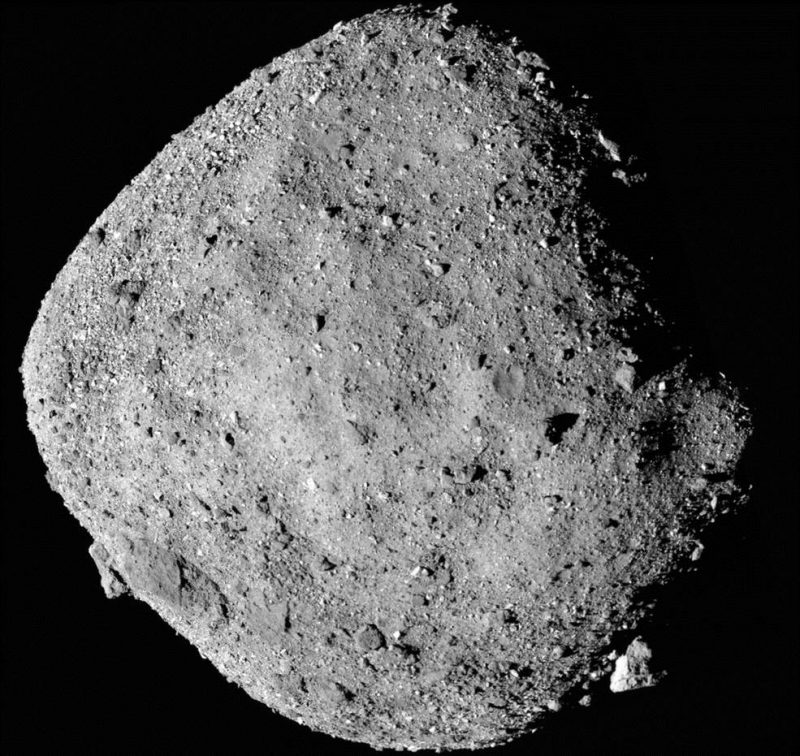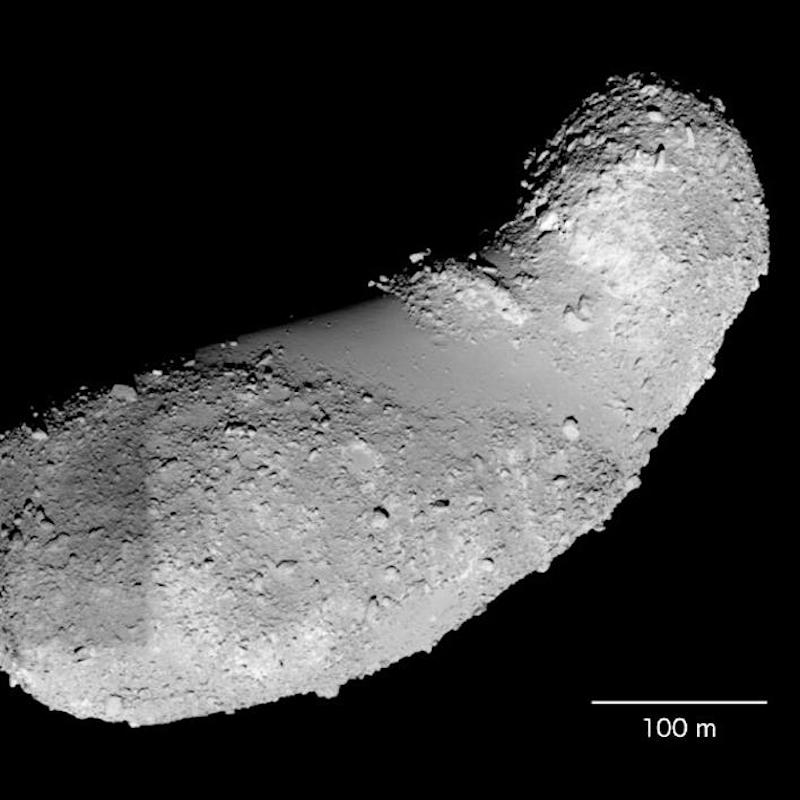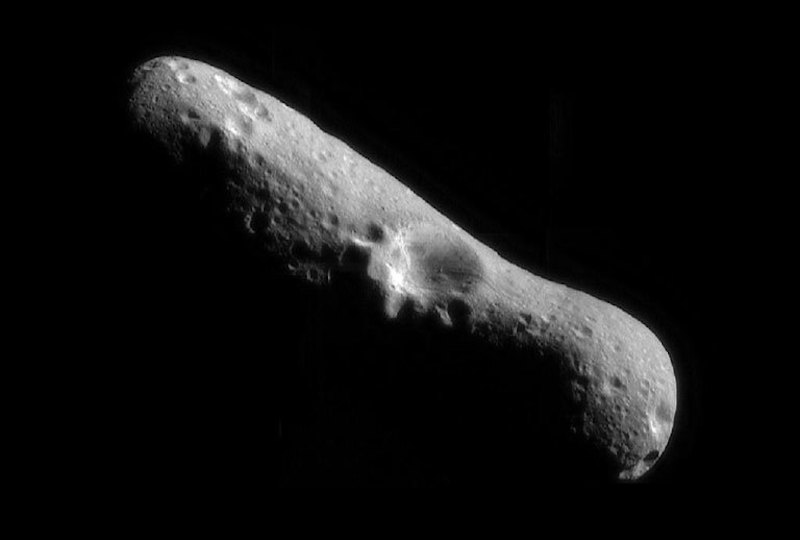
Why does near-Earth asteroid Bennu have so many boulders on its surface? Prior to late 2018, when NASA’s visiting spacecraft OSIRIS-REx visited Bennu, scientists expected the asteroid to have a surface entirely or partly coated in a fine regolith of sand and pebbles. In fact, the REx in OSIRIS-REx stands for Regolith Explorer. But OSIRIS-REx found Bennu’s surface strewn with boulders and large rocks. This month (October 21, 2021), scientists announced they might now have an answer to asteroid Bennu’s boulder mystery.
The new study, published in the peer-reviewed journal Nature on October 6, 2021, comes from the University of Arizona. The study suggests that porous rocks are responsible for the lack of fine regolith on Bunnu’s surface.
Asteroid Bennu’s boulder mystery: rocks but no sand
Scientists had thought Bennu would be covered in fine regolith. Close-up images from a spacecraft showed it nearly completely covered in large boulders. How could that be? As co-author and OSIRIS-REx Principal Investigator Dante Lauretta explained in a NASA statement:
… Mapping and characterizing the surface of the asteroid was a main goal. The spacecraft collected very high-resolution data for Bennu’s entire surface, which was down to 3 millimeters [1/10 inch] per pixel at some locations. Beyond scientific interest, the lack of fine regolith became a challenge for the mission itself, because the spacecraft was designed to collect such material.

Machine learning
Saverio Cambioni, at the University of Arizona and MIT and lead author of the new paper, tried to solve the mystery using machine learning and temperature data. He said:
When the first images of Bennu came in, we noted some areas where the resolution was not high enough to see whether there were small rocks or fine regolith. We started using our machine learning approach to distinguish fine regolith from rocks using thermal emission (infrared) data. Only machine learning could efficiently explore a dataset this large.
Thermal radiation, or heat radiation, helped scientists tell the difference between fine regolith and larger rocks and boulders on Bennu. Thermal radiation is emitted by a heated surface in all directions. Bennu, whose orbit around the sun is in the same realm of the solar system as Earth’s (hence the label near-Earth asteroid) gets a bit closer to the sun at its closest than Earth does. The name of this asteroid, Bennu, relates to an ancient Egyptian mythological bird associated with the sun, creation, and rebirth. Just as Earth is warmed by the sun, so is Bennu. The re-emitted thermal radiation is what let scientists solve the boulder mystery.
It helped because the thermal radiation of fine regolith is different from that of larger rocks. In fine regolith, the size of the particles controls the thermal emission. But, in larger rocks, the porosity of the rocks controls this emission.
For their testing, the researchers created a library of thermal emission samples, based on different combinations of fine regolith and porous rocks. The machine learning then “connected the dots” between the samples.
In total, 122 areas on Bennu were analyzed in this way, during both day and night.
Surprises on Bennu
The results were surprising to the researchers. The fine regolith was not simply randomly distributed on the asteroid’s surface. Rather, there was an increase of several tens of percent in the few areas where rocks are non-porous. However, it was lower in regions of highly porous rocks (most of the surface).
The scientists say this means that Bennu’s porous rocks produce very little regolith. This is due to the rocks being compressed rather than shattered by meteoroid impacts. The voids in the rocks act like a cushion, helping to protect the rocks from the impacts. In essence, the rocks are self-protected to some degree against impacts. As co-author Chrysa Avdellidou, a scientist at the French National Center for Scientific Research (CNRS) and the Lagrange Laboratory of the Côte d’Azur Observatory and University in France, commented:
Basically, a big part of the energy of the impact goes into crushing the pores restricting the fragmentation of the rocks and the production of new fine regolith.
Cambioni and his colleagues also showed that cracking caused by the heating and cooling of Bennu’s rocks proceeds more slowly in porous rocks than in denser rocks. This happens as the asteroid rotates through day and night, and further impedes the production of fine regolith.
Jason Dworkin, OSIRIS-REx project scientist at NASA’s Goddard Space Flight Center, added:
When OSIRIS-REx delivers its sample of Bennu (to Earth) in September 2023, scientists will be able to study the samples in detail. This includes testing the physical properties of the rocks to verify this study.

Different kinds of asteroids
The findings are consistent with those of other asteroids, and highlight differences between different types of asteroids. For example, Ryugu is a B-type carbonaceous asteroid rich in carbon, like Bennu. It also is covered in porous rocks and lacks fine regolith. Those results came from Japan’s Hayabusa2 mission.
In contrast, Itokawa, a stony S-type asteroid visited by the earlier Hayabusa mission in 2005, has abundant fine regolith on its surface. In agreement with that, a previous study found that its rocks are less porous than those on Bennu and Ryugu.
As co-author Marco Delbo at CNRS and Lagrange Laboratory said:
For decades, astronomers disputed that small, near-Earth asteroids could have bare-rock surfaces. The most indisputable evidence that these small asteroids could have substantial fine regolith emerged when spacecraft visited S-type asteroids Eros and Itokawa in the 2000s and found fine regolith on their surfaces.
Extrapolating the results to other asteroids
The findings strongly suggest a key distinction between carbonaceous and S-type asteroids. Based on this, researchers now predict that in future observations of other asteroids, carbonaceous asteroids will be largely free of fine regolith. On S-type asteroids, however, fine regolith should be common. Carbonaceous asteroids are the most common on the solar system. According to Cambioni:
This is an important piece in the puzzle of what drives the diversity of asteroids’ surfaces. Asteroids are thought to be relics of the early solar system, so understanding the evolution they have undergone in time is crucial to comprehending how the solar system formed and evolved. Now that we know this fundamental difference between carbonaceous and S-type asteroids, future teams can better prepare sample collection missions depending on the nature of the target asteroid.
As also noted in the paper:
We infer that regolith blankets are uncommon on carbonaceous asteroids, which are the most numerous type of asteroid. By contrast, these terrains should be common on stony asteroids, which have less porous rocks and are the second-most populous group by composition.


A primitive world with ancient water and organics
Bennu is an ancient relic left over from the formation of the solar system. OSIRIS-Rex found evidence for hydrated minerals on its surface. This points to ancient water, likely on the larger parent body that Bennu broke off of. Being carbon-rich, Bennu is also thought to have organic compounds on its surface, the precursors to life.
OSIRIS-Rex is now on its way back to Earth. The sample return capsule, with its precious samples of Bennu, is expected to land on September 24, 2023.
Bottom line: In a surprise to scientists, the OSIRIS-REx spacecraft found the asteroid Bennu covered in boulders, not fine sand-like regolith as had been expected. A new study says this is because the rocks on Bennu are so porous.
Source: Fine-regolith production on asteroids controlled by rock porosity











